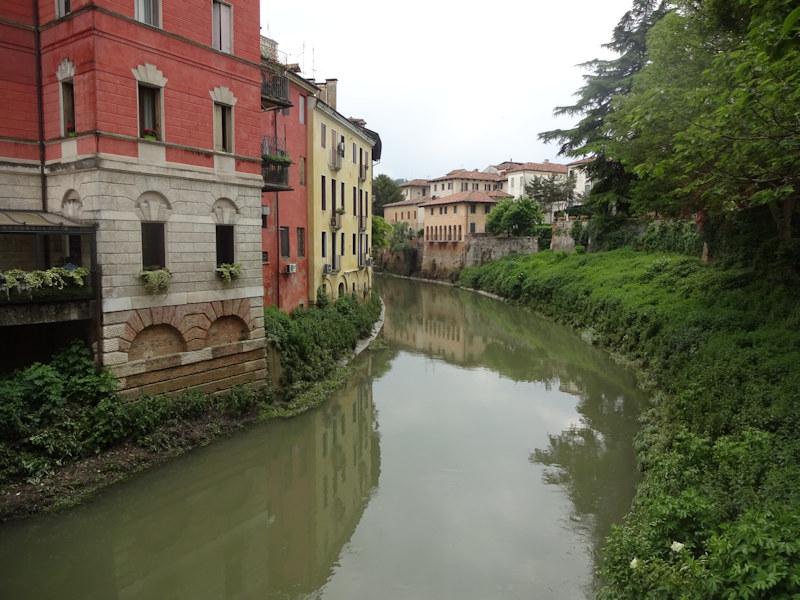You may not find this terribly rewarding unless you're included here, so this is a good time for casual and random browsers to turn back before they get too caught up in the sweep and majesty of the proceedings and can't let go.

The post office

A mini-piazza cater-cornered from the post office at the head of Contrà Garibaldi

The Contrà Giuseppe Garibaldi walking westward, with the cathedral belltower stuck onto a corner of the Palazzo delle Opere Sociali, built in 1808 over a hospital built in the 1350s by the authorities representing the Della Scala family, intended as a "casino" for well-heeled locals, but presently belonging to the Catholic Diocese of Vicenza.

A "temporary store" in the former Cinema Italia, on the Contrà Pescherie Vecchie

The apse-end of the Duomo, with the belltower across the street on the left

The back of the Duomo

The Torre dei Loschi, one of a few remaining medieval private family fortifications in Vicenza, perhaps built in the early 12th century, and said to have been spared from destruction by Emperor Frederick II because it's so close to the Cathedral.

The Oratorio del Gonfalone, or Banner, facing the Piazza del Duomo, begun in the late 16th century by the new Confraternita della Madonna del Gonfalone, led by Count Chiericati, apparently named in the hopes of getting associated with the Roman confraternity of the same name and winning privileges and indulgences from the pope. It was long important for its work with charities for the city's poor, and also became a centre for high-born people hoping to retard the reforms from the Council of Trent.

The medieval Bishop's Palace on the Piazza del Duomo, with a well-regarded Diocesan Museum

The southern side of the Duomo and the dome for which Palladio provided the design

The Cattedrale di Santa Maria Annunziata, or Duomo di Vicenza, was begun in 1482 and only completed in the 1560s, with Palladio's dome. The Allied bombers blew the daylights out of the place, and evidently only the original façade survived.


The northern side of the duomo, with reconstructed side chapels, and the northern door designed by Palladio

Back to the Corso Andrea Palladio, still westward towards the Castello

The 19th century neoclassical church of San Marcello dette dei Filippini

In the Piazza del Castello, with the Torrione di Porta Castello, or Tower of the Castle Gate, first built by the tyrant Ezzelino III da Romana, destroyed when he was overthrown, then restored and enlarged by Mastino II della Scala into a proper fortress with four corner towers and this tower as a keep, surrounded by a moat.

The western gate (the ancient Porta San Felice) at the foot of the Corso Palladio, the decumanus maximus in Roman times, and, on the far side, the resumption of the Via Postumius on the way via Verona to Genoa.

Outside the western gate. At the end of its militarily useful life, in about 1630 the Valmarana family bought the castle and turned it into a residence, but in 1805 most of the fortress was bombarded to smithereens by Napoleon's army chasing the Austrians out.

The Giardino Salvi just outside the gate, created in1592 by the Valmarana family as part of their holdings in the neighborhood

Hercules and a lot of other statues, and . . .

. . . the Loggia Valmarana, built in 1591 by a student of Palladio's and intended as a place for intellectuals to enjoy profound conversations

Palazzo Porto in Piazza del Castello, begun by Palladio for the Porto family in 1571, completed to this point by Vincenzo Scamozzi, but never finished; it's thought that seven bays were planned, demolishing parts of the family residence to the left as the bays were completed, but for unknown reasons the family called the project off.

Garibaldi's statue in the Piazza del Castello

The Piazza del Castello, from the Palazzo Thiene Bonin Longare, planned by Palladio in 1572 and probably completed by Vincenzo Scamuzzo

Haunting eyes, in a gallery along the Corso Palladio ('Il canto della terra', Andrea Bissoni, 1909)

On the Corso Palladio, the Torre di Bissari in the background

In the tiny Contrà delle Morette

Street scene, approaching the Chiesa di San Gaetano

An old bookshop


Past the Piazza dei Signori again

We're dashing down to the river Retrone to see the Ponte San Michele, built in about 1623 and still going strong.

Going strong, with a little help!

From the Ponte San Michele, the Ponte San Paolo upstream

Along the Contrà San Paolo

The 17th century Ponte San Michele, from the Ponte San Paolo


The Contrà San Paolo with the Piazza delle Erbe up to the left

The Contrà Pescaria, leading to the Piazza delle Erbe marketplace and the back of the Basilica Palladiana

The Piazza delle Erbe

Recycling old columns wherever they can be found

The back steps of Palladio's Basilica

Stairs leading to the Piazzetta Palladio

Back across the Piazza dei Signori, with fewer crowds

And back to the Erector-set parking garages, then on to the Castello Soave

















 Dwight Peck's personal website
Dwight Peck's personal website













































